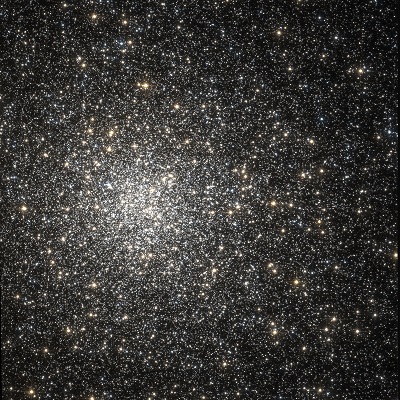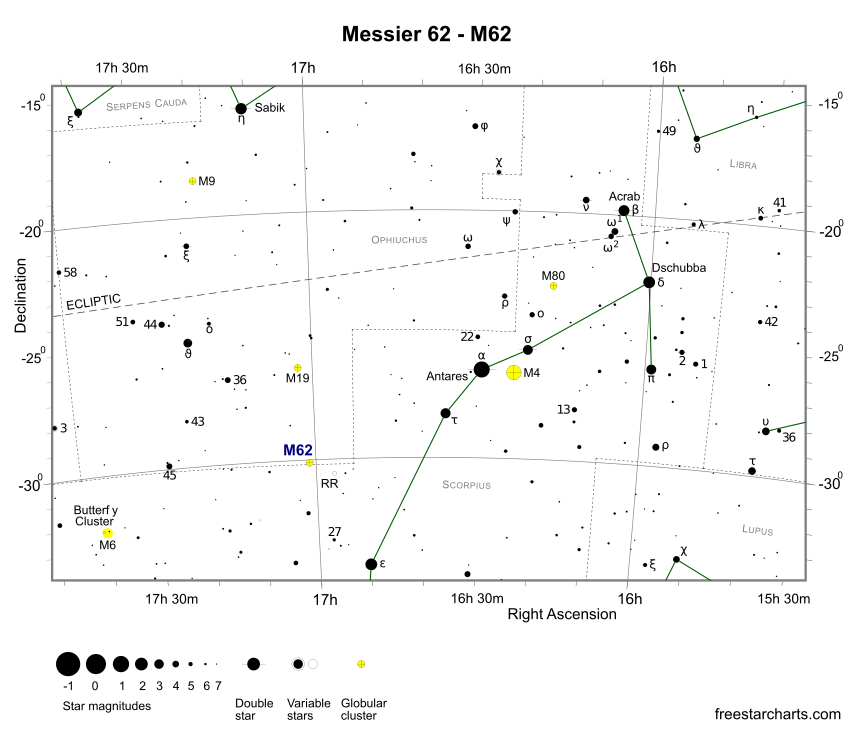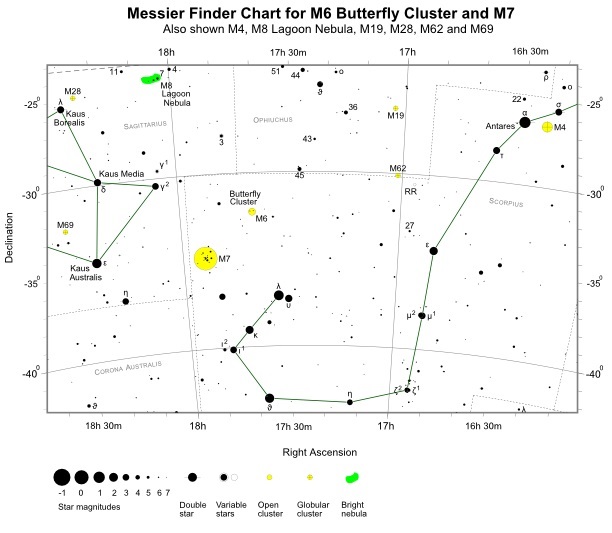M62 is a magnitude +6.5 globular cluster in the constellation of Ophiuchus, right at the border with Scorpius. It's positioned close to the Milky Way centre, which may be the reason why it's one of the most irregular shaped globulars known. At a distance of only 6,100 light-years from the galactic centre, this cluster is subject to large deforming tidal forces. From Earth, it's considerably further away at 22,200 light-years.
M62 was discovered by Charles Messier on June 7, 1771. However, he didn't accurately measure its position until 1779 when including it in his catalogue. William Herschel first resolved the object into stars, describing it as a miniature version of M3. Finding M62 can be challenging since there are no bright stars positioned nearby. One method is to imagine a right angle triangle consisting of Antares (α Sco - mag. +1.0) and epsilon Scorpii (ε Sco - mag. +2.3) with M62 at the third corner. Antares is 7.5 degrees northwest of M62 with ε Scorpii 4.75 degrees to the southwest.
M62 is visible with binoculars as a faint small fuzzy ball of light. However, since it's located among the rich Milky Way starfields it can be easily missed. The cluster is best seen from tropical and Southern Hemisphere locations during the months of May, June and July. For mid-latitude Northern Hemisphere observers, it's a tricky object that doesn't rise particularly high above the southern horizon and therefore never well placed. Positioned 4.5 degrees north of M62 is the slightly fainter but larger globular cluster M19 (mag. +7.2).


Finder Chart for M62 - pdf format (credit:- freestarcharts)

When viewed through an 80mm (3.1-inch) telescope, M62 appears as a diffuse ball of light with a bright core. On nights of good seeing and transparency, a 200mm (8-inch) scope at medium to high magnifications will begin to resolve the outer edges. Also noticeable is the oval shape of the cluster, with the long axis orientated in the north-south direction. The centre of the globular appears condensed and more compact than its neighbour, M19. In addition, averted vision helps, but larger size amateur scopes are required for better resolution and deeper views.
In total, M62 covers 15 arc minutes of sky, which corresponds to a spatial diameter 96 light-years. Visually it appears smaller at about 8 to 10 arc minutes. This globular contains a high number of variable stars of which at least 89 are know, many of them of the RR Lyrae type. It's also likely that at some point in its history it has undergone a core collapse, similar to M15, M30 and M70.
M62 Data Table
| Messier | 62 |
|---|---|
| NGC | 6266 |
| Object Type | Globular cluster |
| Constellation | Ophiuchus |
| Distance (light-years) | 22,200 |
| Apparent Mag. | +6.8 |
| RA (J2000) | 17h 01m 12.5s |
| DEC (J2000) | -30d 06m 44s |
| Apparent Size (arc mins) | 15 x 15 |
| Radius (light-years) | 48 |
| Age (years) | 11.78 Billion |
| Number of Stars | 150,000 |
| Notable Features | Very irregular in shape. Contains a high number of variable stars (at least 89) |